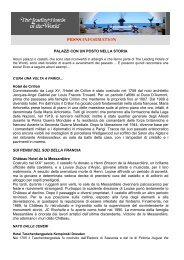Create successful ePaper yourself
Turn your PDF publications into a flip-book with our unique Google optimized e-Paper software.
Once UpOn a Time <strong>in</strong> paris…<br />
Hotel de crillon<br />
Commissioned by Louis XV, Hotel de Crillon was built <strong>in</strong> 1758<br />
by noted architect Jacques-Ange Gabriel for Louis Francois<br />
Trouard. For a time, he rented it to the Duke d’Aumont,<br />
before it passed to the Crillon family, who reta<strong>in</strong>ed ownership<br />
until 1907. In 1909 it began its illustrious era as a hotel. From<br />
its beg<strong>in</strong>n<strong>in</strong>gs, the Crillon has played a part <strong>in</strong> French history:<br />
Marie Anto<strong>in</strong>ette took piano lessons <strong>in</strong> one of the large, firstfloor<br />
suites, now named the Marie Anto<strong>in</strong>ette Suite; all of the<br />
meet<strong>in</strong>gs lead<strong>in</strong>g up to the formation of the League of Nations<br />
<strong>in</strong> 1919 took place at the hotel; it served as Allied headquarters<br />
<strong>in</strong> World War I, and as the residence for the commanders of<br />
the French and British forces <strong>in</strong> World War II. After the<br />
Liberation <strong>in</strong> 1944, it became the base for American military<br />
commanders and diplomats on missions to Paris. H<strong>in</strong>ts of its<br />
aristocratic past can still be seen <strong>in</strong> the Wedgewood porcela<strong>in</strong><br />
medallions <strong>in</strong> the ceil<strong>in</strong>g of the Salon des Aigles; and <strong>in</strong> Les<br />
Ambassadeurs restaurant – once the ballroom of the home –<br />
<strong>with</strong> its crystal chandeliers and marble floor.<br />
On a Hillside <strong>in</strong> THe sOUTH Of france…<br />
chateau Hotel de la messardière<br />
Built <strong>in</strong> the 19th century, the Château was given to Henri<br />
Brisson de la Messardière, an outstand<strong>in</strong>g cavalry officer, and<br />
Louise Dupuy d'Anjac, and young artist and musician, for their<br />
wedd<strong>in</strong>g. Follow<strong>in</strong>g Henri's untimely death, Louise was faced<br />
<strong>with</strong> poverty, but the determ<strong>in</strong>ed young widow decided to take<br />
the Château's fate <strong>in</strong>to her own hands by us<strong>in</strong>g it as lodg<strong>in</strong>gs for<br />
prestigious guests. Later, dur<strong>in</strong>g the roar<strong>in</strong>g twenties, the<br />
lounges of La Messardière were the stage for extravagant receptions<br />
and parties. Sadly, Louise's poor management skills slowly<br />
but surely led the Château <strong>in</strong>to decl<strong>in</strong>e. After pass<strong>in</strong>g through<br />
the hands of a series of owners, the Château was once aga<strong>in</strong><br />
faced <strong>with</strong> ru<strong>in</strong>. Stand<strong>in</strong>g alone on the hillside, exposed to the<br />
four w<strong>in</strong>ds (and pillagers), it was widely believed to be haunted.<br />
F<strong>in</strong>ally, <strong>in</strong> 1989, the Château was restored and extended under<br />
the supervision of the chief architect of historical monuments,<br />
J.C. Rochette, and opened <strong>in</strong> 1990 as a hotel. Yet the memory<br />
of the ancient Messardière family is still honored, <strong>with</strong> works of<br />
art by the last descendant, Victoire de la Messardière, adorn<strong>in</strong>g<br />
the Château walls.<br />
nesTled <strong>in</strong> a Valley<br />
schlosshotel Hugenpoet<br />
Schlosshotel Hugenpoet is a moated castle situated <strong>in</strong><br />
Germany’s Ruhr Valley. The first owners were the Barons of<br />
Nesselrode, called Hugenpoet. They, like many other knights<br />
of their times, were frequently embroiled <strong>in</strong> feuds and ambushed<br />
the heavily armed wagons loaded <strong>with</strong> merchandise<br />
which passed by. Hugenpoet was not spared either dur<strong>in</strong>g the<br />
troubled times <strong>in</strong> the Middle Ages. In 1478 the castle was taken<br />
by storm and burnt down; only parts of it rema<strong>in</strong>ed stand<strong>in</strong>g<br />
until 1756. Interior features of note <strong>in</strong>clude the magnificent<br />
staircase, carved from the f<strong>in</strong>est black marble, as well as three<br />
fireplaces, <strong>in</strong>stalled <strong>in</strong> the early 19th century. Made of Bamberg<br />
sandstone, they were created between 1577 and 1578, and are<br />
deemed to be among the most splendid works of the Late<br />
Renaissance based on pa<strong>in</strong>t<strong>in</strong>gs of Rafael. After World War II,<br />
the ground floor of the castle was leased by the Folkwang<br />
Museum whose build<strong>in</strong>g had been destroyed by bombs. Part of<br />
the museum’s renowned collection was displayed there until<br />
the museum returned to Essen <strong>in</strong> 1954. That same year,<br />
Düsseldorf hotelier, Kurt Neumann was persuaded to jo<strong>in</strong> the<br />
project of turn<strong>in</strong>g the castle <strong>in</strong>to a hotel, and it opened for<br />
Easter <strong>in</strong> 1955. Over the years, meet<strong>in</strong>gs and conferences of<br />
political importance have taken place at Hugenpoet; the most<br />
important one be<strong>in</strong>g the G7 Summit <strong>in</strong> 1994.<br />
an emerald isle Gem<br />
olISSIppo lapa palace<br />
ashford castle<br />
Dat<strong>in</strong>g back to the 13th century, Ashford Castle was orig<strong>in</strong>ally

















